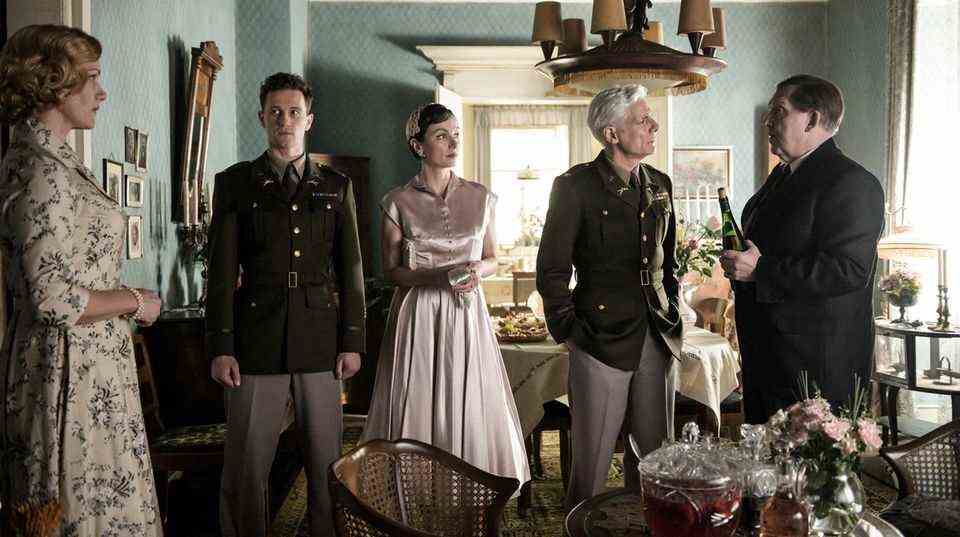TV review
“A touch of America”
Definitely well meant: A six-part story about a forbidden love in post-war Germany
Scene from “A Touch of America”: Marie (Elisa Schlott) teaches the US soldier George (Reomy D. Mpeho) to ride a bicycle.
© SWR / FFP New Media GmbH / Ben Knabe,
Schwarzer GI loves young country women: The six-part “A touch of America” tells of the encounter between US soldiers and Germans in the post-war period – but does not go beyond a series of clichés.
German television has long drawn its inspiration from German history. Phases beyond the twelve dark years are also being discussed more and more often. For example the imperial era in the first season of “Charité.” The late 1950s and 60s in the “Ku’damm” range. Or the 1970s in the Amazon series “Wir Kinder vom Bahnhof Zoo”.
While all of these productions are playing in Berlin, the six-part “A Touch of America” is going into the provinces. The story takes place in the fictional town of Kaltenstein in the Palatinate and tells of an episode in post-war history that has so far not been discussed much: the encounter between the German population and the GIs stationed there – and the resulting love affairs.
The focus is on two families: On the one hand, there are the wealthy Strumms around the powerful mayor Friedrich Strumm (Dietmar Bär). He, just a Nazi loyal to the line, quickly came to terms with the new circumstances and is already doing business with the Americans stationed in the village. On the other hand there is the extremely poor farming family Kastner, who can barely make ends meet and on whose land the Americans want to build a hospital.
“A touch of America” in the Palatinate
Both families are united by the friendship of their daughters, the fun-loving Erika Strumm (Franziska Brandmeier) and the serious, withdrawn Marie Kastner (Elisa Schlott). Which also made Erika’s brother Siegfried (Jonas Ney) the marriage vows. Although he has been lost since the war, she still feels bound by the vow.
Marie is bewitched by the black GI George (Reomy D. Mpeho). Just as she gives in to his wooing, Siegried comes back from captivity. Although he is severely traumatized and incapable of any relationship, Maria first decides for him.
It’s all pretty to look at. The cast is terrific, with other roles including Anna Schudt, Samuel Finzi, Julia Koschitz, Aljoscha Stadelmann and Nina Gummich. There are intoxicating dance scenes in the village pub, cheating, betrayal and dark secrets. So everything that brings emotions into the story.
But that is exactly the problem: The setting and the theme of “A Touch of America” are well chosen. One would like to get a reasonably realistic insight into life in those years. Instead, the viewer is served a gigantic sheet of images covered in sugar: Hardly a cliché is left out in order to arouse public interest.
The old cliché: a woman between two men
But even if the time and place are perhaps new: the story of a young woman who stands between two men and has to choose between heart and reason has simply been seen too often to really develop interest.
In addition, it is clear very early on how the story will play out. Almost every twist is predictable. And so, after 270 minutes, you think back to the great feats German filmmakers were once capable of. For example to Edgar Reitz, who with his “Heimat” series tells the story of the nearby Hunsrück precisely and realistically like no one before. Or to Rainer Werner Fassbinder, who in 1979, with “The Marriage of Maria Braun”, spoke with incomparable force of the encounter between German women and black GIs.
Nobody would have expected such a masterpiece from the six-piece. But “A Touch of America” hangs the bar so low that even the term “Pilcherisation” would be flattering. Because the films broadcast on ZDF on Sunday evenings are not that bad.
“A Touch of America” will be broadcast in double episodes on Wednesday, December 1st, Saturday, December 4th and Wednesday, December 8th, starting at 8:15 pm.
All six parts are already now available in the ARD media library



